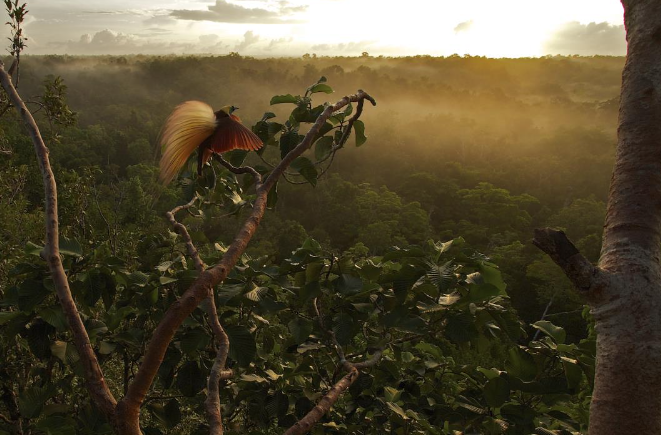The Manokwari Declaration: Challenges ahead in conserving 70% of Tanah Papua’s forests
Versions
- 2019-04-07 (2)
- 2019-04-07 (1)

Additional Files
Deprecated: json_decode(): Passing null to parameter #1 ($json) of type string is deprecated in /home/journal33/public_html/plugins/generic/citations/CitationsPlugin.inc.php on line 49
Aidenvironment (2016). Burning Paradise: The oil palm practices of Korindo in Papua and North Maluku. http://www.aidenvironment.org/wp-content/uploads/2016/09/2016-08-25-FINAL-Korindo-report-English.pdf
Brun, C., Cook, A. R., Lee, J. S. H., Wich, S. A., Koh, L. P., & Carrasco, L. R. (2015). Analysis of deforestation and protected area effectiveness in Indonesia: A comparison of Bayesian spatial models. Global environmental change, 31, 285-295.doi:https://doi.org/10.1016/j.gloenvcha.2015.02.004
Fatem, S. M., Awang, S. A., Pudyatmoko, S., Sahide, M. A., Pratama, A. A., & Maryudi, A. (2018). Camouflaging economic development agendas with forest conservation narratives: A strategy of lower governments for gaining authority in the re-centralising Indonesia. Land Use Policy, 78, 699-710. doi: https://doi.org/10.1016/j.landusepol.2018.07.018
Franky. Y.L., S. Moragan. (2015). West Papua Oil Palm Atlas: the companies behind the plantation explosion
Fraser, B. (2018). New Papua Atlas tracks impact of plantations, roads on forests: https://forestsnews.cifor.org/58088/new-papua-atlas-tracks-impact-of-plantations-roads-on-forests?fnl=en.
Greenpeace. (2018). Final countdown: Now or never to reform the oil palm industry: https://www.greenpeace.org/international/publication/18455/the-final-countdown-forests-indonesia-palm-oil/
Indonesian Bureau of Statistics. (2018). www.bps.go.id
Jong, H. N. (2018). In early push into Papua, palm oil firms set stage for massive forest plunder: https://news.mongabay.com/2018/01/in-early-push-into-papua-palm-oil-firms-set-stage-for-massive-forest-plunder/
Klute. M. (2008). Forests in Papua: Data and Facts. http://www.biofuelwatch.org.uk/docs/papua_article.pdf.
Manokwari Declaration (2018). http://adventurecarstensz.com/2018/10/20/international-conference-on-biodiversity-ecotourism-creative-economy-icbe-2018-2/;http://bentarapapua.org/page/press_detail/87
Marshall. A.J., B.M. Beehler. (2007). The Ecology of Papua, Parts One and Two. Periplus, Singapore
Mittermeier, R. A., Myers, N., Thomsen, J. B., Da Fonseca, G. A., & Olivieri, S. (1998). Biodiversity hotspots and major tropical wilderness areas: approaches to setting conservation priorities. Conservation biology, 12(3), 516-520. doi:https://doi.org/10.1046/j.1523-1739.1998.012003516.x
Newbold, T., Hudson, L. N., Arnell, A. P., Contu, S., De Palma, A., Ferrier, S., ... & Burton, V. J. (2016). Has land use pushed terrestrial biodiversity beyond the planetary boundary? A global assessment. Science, 353(6296), 288-291. doi:https://doi.org/10.1126/science.aaf2201
Sloan, S., Campbell, M. J., Alamgir, M., Engert, J., Ishida, F. Y., Senn, N., ... & Laurance, W. F. (2019). Hidden challenges for conservation and development along the Trans-Papuan economic corridor. Environmental Science & Policy, 92, 98-106. doi:https://doi.org/10.1016/j.envsci.2018.11.011
Steni, B. D. Nepstad. (2018). To conserve West Papua, start with land rights: https://news.mongabay.com/2018/10/to-conserve-west-papua-start-with-land-rights-commentary/#_edn1
Tabloid Jubi. (2018). Ternyata ada 307 bahasa daerah di Papua: http://tabloidjubi.com/16/2014/04/01/ternyata-bahasa-daerah-di-papua-sebanyak-307-buah/.
UNESCO. (2015). Report on the World Heritage Reactive Monitoring Mission to Lorentz National Park, Indonesia: https://whc.unesco.org/document/136459
World Bank. Infrastructure Strategies for Papua and West Papua: https://siteresources.worldbank.org/INTINDONESIA/Resources/Publication/280016-1235115695188/5847179-1263873728984/infrastructure.en.pdf
Copyright (c) 2019 Forest and Society

This work is licensed under a Creative Commons Attribution 4.0 International License.
This is an open access journal which means that all contents is freely available without charge to the user or his/her institution. Users are allowed to read, download, copy, distribute, print, search, or link to the full texts of the articles in this journal without asking prior permission from the publisher or the author. This is in accordance with the BOAI definition of open access.
Submission of an article implies that the work described has not been published previously (except in the form of an abstract or as part of a published lecture or academic thesis), that it is not under consideration for publication elsewhere, that its publication is approved by all authors and tacitly or explicitly by the responsible authorities where the work was carried out, and that, if accepted, will not be published elsewhere in the same form, in English or in any other language, without the written consent of the Publisher. An article based on a section from a completed graduate dissertation may be published in Forest and Society, but only if this is allowed by author's(s') university rules. The Editors reserve the right to edit or otherwise alter all contributions, but authors will receive proofs for approval before publication.
Forest and Society operates a CC-BY 4.0 © license for journal papers. Copyright remains with the author, but Forest and Society is licensed to publish the paper, and the author agrees to make the article available with the CC-BY 4.0 license. Reproduction as another journal article in whole or in part would be plagiarism. Forest and Society reserves all rights except those granted in this copyright notice







